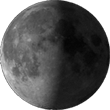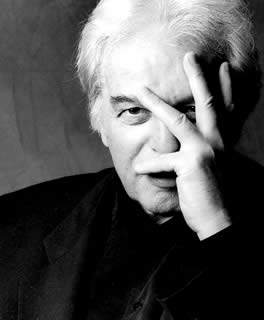
Alejandro Jodorowsky (Spanish pronunciation: [aleˈxandɾo xodoˈrovski]) (born 17 February 1929) is a Chilean filmmaker, playwright, composer and writer with a large cult following. Jodorowsky was born in 1929 in the coastal town of Tocopilla, Chile to parents who were Jewish immigrants from Russia. His father, Jaime Jodorowsky, was a merchant who was largely abusive to his wife Sara Felicidad, at one time accused her of flirting with a customer. Angered, he subsequently beat and raped her, getting her pregnant, which led to the birth of Alejandro. Because of this brutal conception, Sara both hated her husband and disliked her son, telling him that “I cannot love you” and rarely showing him tenderness. Alejandro also had an elder sister, but disliked her for he believed that she was selfish, doing “everything to expel me from the family so that she could be the centre of attention.” Alongside his dislike for his family, he also held contempt for many of the local people, who viewed him as an outsider because of his status as the son of immigrants, and also for the American mining industrialists who worked locally and treated the Chilean people badly. It was this treatment at the hands of Americans that led to his later condemnation of American imperialism and neo-colonialism in Latin America in several of his films. Nonetheless he liked his local area, and was greatly unhappy when he was forced to leave it aged nine years old, something he blamed his father for. His family subsequently moved to the city of Santiago, Chile. 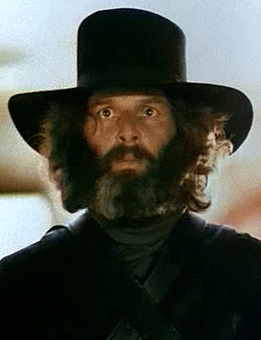 He immersed himself in reading, and also began writing poetry, having his first poem published when he was sixteen years old, alongside associating with such Chilean poets as Nicanor Parra and Enrique Lihn. Becoming interested in the political ideology of anarchism, he began attending college, studying psychology and philosophy, but stayed for only two years. After dropping out, and having an interest in theatre and particularly mime, he took up employment as a clown in a circus and began a career as a theatre director. Meanwhile, in 1947 he founded his own theatrical troupe, the Teatro Mimico, who by 1952 had fifty members, and the following year he wrote his first play, El Minotaura (The Minotaur). Nonetheless, Jodorowsky felt that there was little for him left in Chile, and so that year he moved to Paris, France. In 2000, Jodorowsky won the Jack Smith Lifetime Achievement Award from the Chicago Underground Film Festival (CUFF). He attended the festival and his films were shown, including El Topo and The Holy Mountain, which at the time had grey legal status. According to festival director Bryan Wendorf, it was an open question of whether CUFF would be allowed to show both films, or whether the police would show up and shut the festival down. Until 2007, Fando y Lis and Santa sangre were the only Jodorowsky’s works available on DVD. Neither El Topo nor The Holy Mountain were available on videocassette or DVD in the United States or the United Kingdom, due to ownership disputes with distributor Allen Klein. After the dispute’s settlement in 2004, however, plans to re-release Jodorowsky’s films were announced by ABKCO Films. On January 19, 2007, the website announced that on May 1, 2007, Anchor Bay released a box set including El Topo, The Holy Mountain, and Fando y Lis. A limited edition of the set includes both the El Topo and The Holy Mountain soundtracks. And, in early February 2007, Tartan Video announced its May 14, 2007, release date for the UK PAL DVD editions of El Topo, The Holy Mountain and the 6-disc box set which, alongside with the aforementioned feature films, includes the 2 soundtrack CDs, as well as separate DVD editions of Jodorowsky’s 1968 debut feature Fando y Lis (with his 1957 short La cravate aka Les têtes interverties, included as an extra) and the 1994 feature-length documentary La constellation Jodorowsky. Notably, Fando y Lis and La cravate were extensively digitally restored and remastered in London during late 2006, thus providing the perfect complement to the quality restoration work undertaken on El Topo and The Holy Mountain in the States by Abkco, and ensuring that the presentation of Fando y Lis is a significant improvement over the 2001 Fantoma DVD edition. Prior to the availability of these legitimate releases, only inferior quality, optically censored bootleg copies of both El Topo and The Holy Mountain have been circulated on the Internet and on DVD. In the 1990s and early 2000s, Jodorowsky attempted to make a sequel to El Topo, called at different times The Sons of El Topo and Abelcain, but could not find investors for the project. In an interview with Premiere Magazine, Jodorowsky said he intended his next project to be a gangster film called King Shot. However, in an interview with The Guardian newspaper in November 2009, Jodorowsky revealed that he was unable to find the funds to make King Shot, and would instead be entering preparations on Sons of El Topo, for which he claimed to have signed a contract with “some Russian producers”. Raymond J. Markovich, Olga Mirimskaya and Arcadiy Golybovich – Parallell Media Films on a film entitled Abel Cain which is the sequel to his 1970 film El Topo. Jodorowsky spent over fifteen years reconstructing the original form of the Tarot de Marseille. From this work he moved in to more therapeutic work in three areas: psychomagic, psychogenealogy and initiatic massage. Psychomagic aims to heal psychological wounds suffered in life. This therapy is based on the belief that the performance of certain acts can directly act upon the unconscious mind, releasing it from a series of traumas, some of which are passed down from generation to generation. Psychogenealogy includes the studying of the patient’s personality and family tree in order to best address their specific sources. It is similar, in its phenomenological approach to genealogy, to the Constellations pioneered by Bert Hellinger. Jodorowsky has several books on his therapeutic methods, including Psicomagia: La trampa sagrada (Psychomagic: The Sacred Trap) and his autobiography La danza de la realidad (The Dance of Reality), which he filming as a feature length film in March 2011. To date he has published over 23 novels and philosophical treaties, along with dozens of articles and interviews. His books are widely read in Spanish and French, but are for the most part unknown to English-speaking audiences. Throughout his career, Jodorowsky has gained a reputation as a philosopher and scholar who presents the teachings of religion, psychology and spiritual masters, by molding them into pragmatic and imaginative endeavors. All of his enterprises integrate an artistic approach. Currently Jodorowsky dedicates much of his time to lecturing about his work. For a quarter of a century, Jodorowsky held classes and lectures for free, in cafés and universities all over the city of Paris. Typically, such courses or talks would begin on Wednesday evenings as tarot divination lessons, and would culminate in an hour long conference, also free, where at times hundreds of attendees would be treated to live demonstrations of a psychological “arbre généalogique” (“tree of genealogy”) involving volunteers from the audience. In these conferences, Jodorowsky would pave the way to building a strong base of students of his philosophy, which deals with understanding the unconscious as the “over-self” which is composed of many generations of family relatives, living or deceased, acting on our own psyche, well into our adult lives, and causing our compulsions. It is important to note that of all his work, Jodorowsky considers these activities to be the most important of his life. Though such activities only take place in the insular world of Parisian cafés, he has devoted thousands of hours of his life to teaching and helping people “become more conscious,” as he puts it. Presently, these talks have dwindled to once a month and take place at the “Librairie Les Cent Ciels” in Paris. [wiki]
He immersed himself in reading, and also began writing poetry, having his first poem published when he was sixteen years old, alongside associating with such Chilean poets as Nicanor Parra and Enrique Lihn. Becoming interested in the political ideology of anarchism, he began attending college, studying psychology and philosophy, but stayed for only two years. After dropping out, and having an interest in theatre and particularly mime, he took up employment as a clown in a circus and began a career as a theatre director. Meanwhile, in 1947 he founded his own theatrical troupe, the Teatro Mimico, who by 1952 had fifty members, and the following year he wrote his first play, El Minotaura (The Minotaur). Nonetheless, Jodorowsky felt that there was little for him left in Chile, and so that year he moved to Paris, France. In 2000, Jodorowsky won the Jack Smith Lifetime Achievement Award from the Chicago Underground Film Festival (CUFF). He attended the festival and his films were shown, including El Topo and The Holy Mountain, which at the time had grey legal status. According to festival director Bryan Wendorf, it was an open question of whether CUFF would be allowed to show both films, or whether the police would show up and shut the festival down. Until 2007, Fando y Lis and Santa sangre were the only Jodorowsky’s works available on DVD. Neither El Topo nor The Holy Mountain were available on videocassette or DVD in the United States or the United Kingdom, due to ownership disputes with distributor Allen Klein. After the dispute’s settlement in 2004, however, plans to re-release Jodorowsky’s films were announced by ABKCO Films. On January 19, 2007, the website announced that on May 1, 2007, Anchor Bay released a box set including El Topo, The Holy Mountain, and Fando y Lis. A limited edition of the set includes both the El Topo and The Holy Mountain soundtracks. And, in early February 2007, Tartan Video announced its May 14, 2007, release date for the UK PAL DVD editions of El Topo, The Holy Mountain and the 6-disc box set which, alongside with the aforementioned feature films, includes the 2 soundtrack CDs, as well as separate DVD editions of Jodorowsky’s 1968 debut feature Fando y Lis (with his 1957 short La cravate aka Les têtes interverties, included as an extra) and the 1994 feature-length documentary La constellation Jodorowsky. Notably, Fando y Lis and La cravate were extensively digitally restored and remastered in London during late 2006, thus providing the perfect complement to the quality restoration work undertaken on El Topo and The Holy Mountain in the States by Abkco, and ensuring that the presentation of Fando y Lis is a significant improvement over the 2001 Fantoma DVD edition. Prior to the availability of these legitimate releases, only inferior quality, optically censored bootleg copies of both El Topo and The Holy Mountain have been circulated on the Internet and on DVD. In the 1990s and early 2000s, Jodorowsky attempted to make a sequel to El Topo, called at different times The Sons of El Topo and Abelcain, but could not find investors for the project. In an interview with Premiere Magazine, Jodorowsky said he intended his next project to be a gangster film called King Shot. However, in an interview with The Guardian newspaper in November 2009, Jodorowsky revealed that he was unable to find the funds to make King Shot, and would instead be entering preparations on Sons of El Topo, for which he claimed to have signed a contract with “some Russian producers”. Raymond J. Markovich, Olga Mirimskaya and Arcadiy Golybovich – Parallell Media Films on a film entitled Abel Cain which is the sequel to his 1970 film El Topo. Jodorowsky spent over fifteen years reconstructing the original form of the Tarot de Marseille. From this work he moved in to more therapeutic work in three areas: psychomagic, psychogenealogy and initiatic massage. Psychomagic aims to heal psychological wounds suffered in life. This therapy is based on the belief that the performance of certain acts can directly act upon the unconscious mind, releasing it from a series of traumas, some of which are passed down from generation to generation. Psychogenealogy includes the studying of the patient’s personality and family tree in order to best address their specific sources. It is similar, in its phenomenological approach to genealogy, to the Constellations pioneered by Bert Hellinger. Jodorowsky has several books on his therapeutic methods, including Psicomagia: La trampa sagrada (Psychomagic: The Sacred Trap) and his autobiography La danza de la realidad (The Dance of Reality), which he filming as a feature length film in March 2011. To date he has published over 23 novels and philosophical treaties, along with dozens of articles and interviews. His books are widely read in Spanish and French, but are for the most part unknown to English-speaking audiences. Throughout his career, Jodorowsky has gained a reputation as a philosopher and scholar who presents the teachings of religion, psychology and spiritual masters, by molding them into pragmatic and imaginative endeavors. All of his enterprises integrate an artistic approach. Currently Jodorowsky dedicates much of his time to lecturing about his work. For a quarter of a century, Jodorowsky held classes and lectures for free, in cafés and universities all over the city of Paris. Typically, such courses or talks would begin on Wednesday evenings as tarot divination lessons, and would culminate in an hour long conference, also free, where at times hundreds of attendees would be treated to live demonstrations of a psychological “arbre généalogique” (“tree of genealogy”) involving volunteers from the audience. In these conferences, Jodorowsky would pave the way to building a strong base of students of his philosophy, which deals with understanding the unconscious as the “over-self” which is composed of many generations of family relatives, living or deceased, acting on our own psyche, well into our adult lives, and causing our compulsions. It is important to note that of all his work, Jodorowsky considers these activities to be the most important of his life. Though such activities only take place in the insular world of Parisian cafés, he has devoted thousands of hours of his life to teaching and helping people “become more conscious,” as he puts it. Presently, these talks have dwindled to once a month and take place at the “Librairie Les Cent Ciels” in Paris. [wiki]
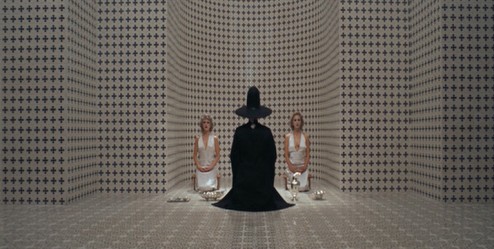
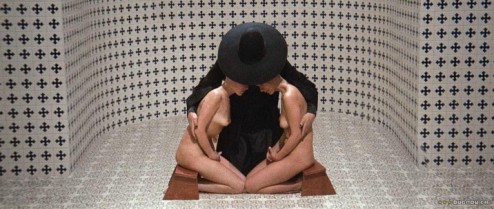
Holy Mountain still shots
Alejandro Jodorowsky on Lady Gaga & Surrealism — April 13, 2011 — Inspirational figures get personal and share a passion with us in AnOther Thing I Wanted to Tell You via anothermag

 May 24th, 1965. A crowd of 2,000 beatniks, activists and hipsters gather in the main hall at the American Students and Artists Center in Montparnasse. Somewhere amongst all the beards and black roll-necks is the Surrealist master Marcel Duchamp. They’re waiting for the penultimate act in what has been an exhausting eight-day extravaganza of “happenings†called The Second Paris Festival of Free Expression. The show about to start is Sacramental Melodrama, the latest offering from terror theatre troupe ‘Panic’, formed by Chilean-born anarchic artist Alejandro Jodorowsky and the bad boy of Spanish stage Fernando Arrabal, and famed for their violent, visceral performances. The lights begin to dim. The curtain rises to reveal a brilliantly white set. A black car is parked centre-stage. A rock band unleashes deafening guitar feedback. A gang of topless women – each painted head-to-toe in white, black and pink – attack the vehicle with hatchets, chains and a giant pair of scissors. Dressed in a black leather fetish uniform and a white crash helmet, Jodorowsky walks out, decapitates two white geese with his gloved hands and throws their spurting heads into the dumbstruck front row…
May 24th, 1965. A crowd of 2,000 beatniks, activists and hipsters gather in the main hall at the American Students and Artists Center in Montparnasse. Somewhere amongst all the beards and black roll-necks is the Surrealist master Marcel Duchamp. They’re waiting for the penultimate act in what has been an exhausting eight-day extravaganza of “happenings†called The Second Paris Festival of Free Expression. The show about to start is Sacramental Melodrama, the latest offering from terror theatre troupe ‘Panic’, formed by Chilean-born anarchic artist Alejandro Jodorowsky and the bad boy of Spanish stage Fernando Arrabal, and famed for their violent, visceral performances. The lights begin to dim. The curtain rises to reveal a brilliantly white set. A black car is parked centre-stage. A rock band unleashes deafening guitar feedback. A gang of topless women – each painted head-to-toe in white, black and pink – attack the vehicle with hatchets, chains and a giant pair of scissors. Dressed in a black leather fetish uniform and a white crash helmet, Jodorowsky walks out, decapitates two white geese with his gloved hands and throws their spurting heads into the dumbstruck front row… 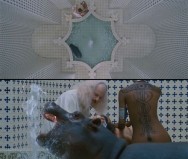 The four-hour onslaught climaxes with a frenzied Jodorowsky whipping the women with the headless birds while dressed in 20 pounds of prime beef. Jump forward almost half a century: Jodorowsky is now 82-years-old, a celebrated author, a respected Tarot master and a living legend thanks to taboo-busting films like El Topo, The Holy Mountain and Santa Sangre. Sat nursing a cup of English tea on a rare visit to London, he ponders the death of Surrealism and whether Lady Gaga copied his steak suit for that dress… Alejandro Jodorowsky: “I liked Lady Gaga’s meat dress. It was funny. But I did that first in my Panic performance. Maybe she has seen what I’ve done – I don’t know. I like to think her song Alejandro was written for me. Her music is interesting. It’s interesting because it’s very free. But it has no meaning because what she’s singing has no hope. It is without hope. It’s only about revolution, which isn’t enough. We need a re-evolution right now, not a revolution. We need something new. Lady Gaga has a lot of energy and that is fantastic, but she is using old Surrealist images. Surrealism was necessary – essential, even – in the 1920s to bridge the gap between rationalism and the subconscious. It started something important. But by the early 60s, it had become petit-bourgeois; it was too intellectual and romantic, and had ground to a halt. It had become respectable. They didn’t like science fiction or rock music or… let’s not make a list: the Surrealists didn’t like anything! I needed to go further than Surrealism, and that’s why I formed Panic. Surrealism – in particular with Salvador Dali – was all about ego. It was all about extreme individualism. And it’s the same with Lady Gaga. But today, individualism is over: to make a change and do something new – to truly wake up people’s minds – we have to do something collective, together as a social community. No more Dali, no more Magritte – no more working just for yourself. We have to work as one. We can do it. We can do it. I sound like Barack Obama now…†— Text by Ben Cobb
The four-hour onslaught climaxes with a frenzied Jodorowsky whipping the women with the headless birds while dressed in 20 pounds of prime beef. Jump forward almost half a century: Jodorowsky is now 82-years-old, a celebrated author, a respected Tarot master and a living legend thanks to taboo-busting films like El Topo, The Holy Mountain and Santa Sangre. Sat nursing a cup of English tea on a rare visit to London, he ponders the death of Surrealism and whether Lady Gaga copied his steak suit for that dress… Alejandro Jodorowsky: “I liked Lady Gaga’s meat dress. It was funny. But I did that first in my Panic performance. Maybe she has seen what I’ve done – I don’t know. I like to think her song Alejandro was written for me. Her music is interesting. It’s interesting because it’s very free. But it has no meaning because what she’s singing has no hope. It is without hope. It’s only about revolution, which isn’t enough. We need a re-evolution right now, not a revolution. We need something new. Lady Gaga has a lot of energy and that is fantastic, but she is using old Surrealist images. Surrealism was necessary – essential, even – in the 1920s to bridge the gap between rationalism and the subconscious. It started something important. But by the early 60s, it had become petit-bourgeois; it was too intellectual and romantic, and had ground to a halt. It had become respectable. They didn’t like science fiction or rock music or… let’s not make a list: the Surrealists didn’t like anything! I needed to go further than Surrealism, and that’s why I formed Panic. Surrealism – in particular with Salvador Dali – was all about ego. It was all about extreme individualism. And it’s the same with Lady Gaga. But today, individualism is over: to make a change and do something new – to truly wake up people’s minds – we have to do something collective, together as a social community. No more Dali, no more Magritte – no more working just for yourself. We have to work as one. We can do it. We can do it. I sound like Barack Obama now…†— Text by Ben Cobb
 sonn
sonn
son on facebook
son on twitter
sonn on tumblr
son on computerlove
 aa
aa
aa on vimeo
aa on facebook
aa on twitter


